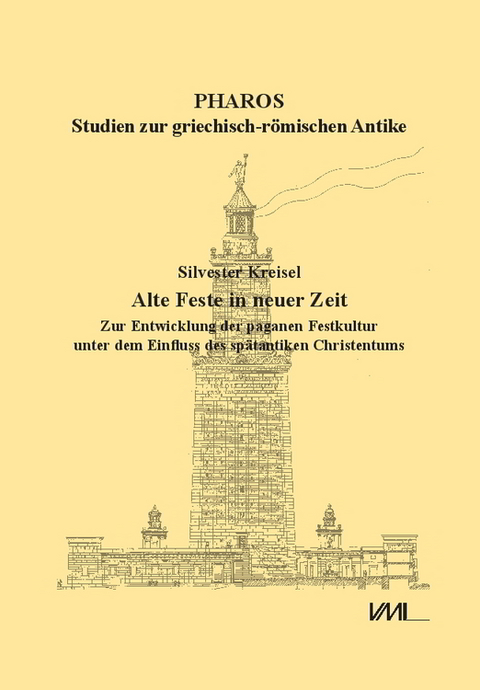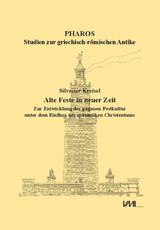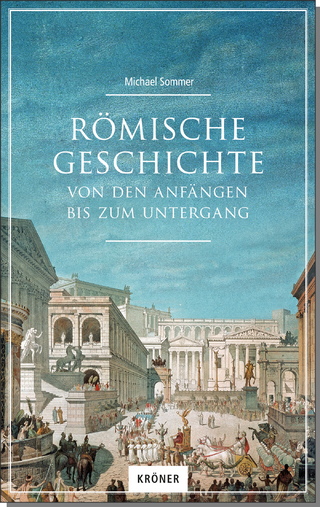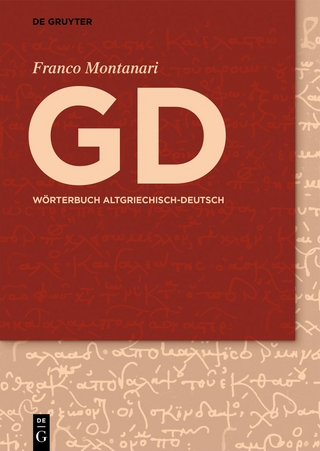Alte Feste in neuer Zeit
Zur Entwicklung der paganen Festkultur unter dem Einfluss des spätantiken Christentums
Seiten
2023
|
1., Aufl.
VML Vlg Marie Leidorf (Verlag)
978-3-86757-278-1 (ISBN)
VML Vlg Marie Leidorf (Verlag)
978-3-86757-278-1 (ISBN)
Die religiöse Transformation der Spätantike stellt eines der wirkmächtigsten Phänomene ihrer Epoche dar. Während an der Relevanz des religiösen Wandels kaum gezweifelt werden kann, sind dessen genaue Auswirkungen auf die spätantike Lebenswelt aber keineswegs offensichtlich. Deutlich wird dieser Sachverhalt an der im vorliegenden Buch untersuchten Entwicklung der spätantiken Festkultur. Der Übergang von einer paganen hin zu einer christlich geprägten Festkultur verlief nämlich keineswegs gleichmäßig. Insbesondere der anhaltende Erfolg einzelner paganer Festivitäten bleibt erklärungsbedürftig. Die Auseinandersetzung mit diesem Problem ist zentrales Thema dieses Buches. Anhand einer Untersuchung der lokalen Festpraktiken in bedeutenden Metropolen des spätantiken Reiches wirft die Studie zentrale Fragen zur Entwicklung paganen Brauchtums unter dem steigenden Einfluss des Christentums auf: Welche Mechanismen und Faktoren bestimmten das Schicksal paganer Festivitäten ? Inwieweit konnten lokale Eigenheiten das Weiterbestehenden traditioneller Festtage beeinflussen ? Wie lässt sich die zum Teil heterogene Entwicklung einzelner paganer Feste – von zügigem Verschwinden bis hin zu andauernder Persistenz – erklären und wo lagen Grenzen des religiösen Wandels ? Die Beschäftigung mit diesen Fragen verspricht nicht nur ein besseres Verständnis der paganen Festkultur in der Spätantike, sondern auch der religiösen Transformation dieser Epoche insgesamt.
The religious transformation of Late Antiquity is one of the most influential phenomena of its time. While there is no doubt regarding the importance of religious change, its precise impact on Late Antique life is far from obvious. This is illustrated by the development in Late Antique celebration culture, investigated in this book. The transformation from a pagan celebration culture to one shaped by Christianity was in no way smooth. In particular, the lasting success of individual pagan festivities remains to be explained. Dealing with this problem is a central focus of the present volume. Based on the investigation of local celebration practices in important metropoles of the Late Antique Roman Empire, this study raises central questions concerning the development of pagan traditions in the context of the increasing influence of Christianity: which mechanisms and factors determined the fate of pagan celebrations? In how far did local peculiarities influence the persistence of traditional feast days? How can we explain the sometimes heterogeneous development of some pagan feasts – from rapid disappearance to continued persistence – and where were the limits of religious change? Tackling these questions promises not only a better understanding of pagan celebration culture in Late Antiquity, but also of the religious transformations of this period more generally. The religious transformation of Late Antiquity is one of the most influential phenomena of its time. While there is no doubt regarding the importance of religious change, its precise impact on Late Antique life is far from obvious. This is illustrated by the development in Late Antique celebration culture, investigated in this book. The transformation from a pagan celebration culture to one shaped by Christianity was in no way smooth. In particular, the lasting success of individual pagan festivities remains to be explained. Dealing with this problem is a central focus of the present volume. Based on the investigation of local celebration practices in important metropoles of the Late Antique Roman Empire, this study raises central questions concerning the development of pagan traditions in the context of the increasing influence of Christianity: which mechanisms and factors determined the fate of pagan celebrations? In how far did local peculiarities influence the persistence of traditional feast days? How can we explain the sometimes heterogeneous development of some pagan feasts – from rapid disappearance to continued persistence – and where were the limits of religious change? Tackling these questions promises not only a better understanding of pagan celebration culture in Late Antiquity, but also of the religious transformations of this period more generally.
The religious transformation of Late Antiquity is one of the most influential phenomena of its time. While there is no doubt regarding the importance of religious change, its precise impact on Late Antique life is far from obvious. This is illustrated by the development in Late Antique celebration culture, investigated in this book. The transformation from a pagan celebration culture to one shaped by Christianity was in no way smooth. In particular, the lasting success of individual pagan festivities remains to be explained. Dealing with this problem is a central focus of the present volume. Based on the investigation of local celebration practices in important metropoles of the Late Antique Roman Empire, this study raises central questions concerning the development of pagan traditions in the context of the increasing influence of Christianity: which mechanisms and factors determined the fate of pagan celebrations? In how far did local peculiarities influence the persistence of traditional feast days? How can we explain the sometimes heterogeneous development of some pagan feasts – from rapid disappearance to continued persistence – and where were the limits of religious change? Tackling these questions promises not only a better understanding of pagan celebration culture in Late Antiquity, but also of the religious transformations of this period more generally. The religious transformation of Late Antiquity is one of the most influential phenomena of its time. While there is no doubt regarding the importance of religious change, its precise impact on Late Antique life is far from obvious. This is illustrated by the development in Late Antique celebration culture, investigated in this book. The transformation from a pagan celebration culture to one shaped by Christianity was in no way smooth. In particular, the lasting success of individual pagan festivities remains to be explained. Dealing with this problem is a central focus of the present volume. Based on the investigation of local celebration practices in important metropoles of the Late Antique Roman Empire, this study raises central questions concerning the development of pagan traditions in the context of the increasing influence of Christianity: which mechanisms and factors determined the fate of pagan celebrations? In how far did local peculiarities influence the persistence of traditional feast days? How can we explain the sometimes heterogeneous development of some pagan feasts – from rapid disappearance to continued persistence – and where were the limits of religious change? Tackling these questions promises not only a better understanding of pagan celebration culture in Late Antiquity, but also of the religious transformations of this period more generally.
| Erscheinungsdatum | 25.01.2023 |
|---|---|
| Reihe/Serie | Pharos Studien zur griechisch-römischen Antike ; 50 |
| Verlagsort | Rahden/Westf. |
| Sprache | deutsch |
| Maße | 152 x 220 mm |
| Gewicht | 1250 g |
| Einbandart | gebunden |
| Themenwelt | Geschichte ► Allgemeine Geschichte ► Altertum / Antike |
| Schlagworte | Christianisierung • Fest • Neutralisierung • Religion • Ritual • Säkularisierung • Zeremonie |
| ISBN-10 | 3-86757-278-X / 386757278X |
| ISBN-13 | 978-3-86757-278-1 / 9783867572781 |
| Zustand | Neuware |
| Haben Sie eine Frage zum Produkt? |
Mehr entdecken
aus dem Bereich
aus dem Bereich
Von den Anfängen bis zum Untergang
Buch | Hardcover (2021)
Alfred Kröner Verlag
35,00 €
die Inszenierung der Politik in der römischen Republik
Buch | Hardcover (2023)
C.H.Beck (Verlag)
48,00 €




